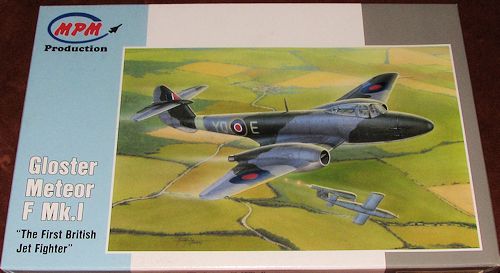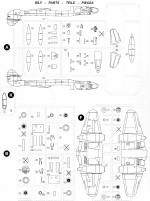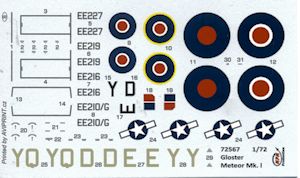
| KIT #: | 72567 |
| PRICE: | $17.00 on sale ($34.00 SRP) |
| DECALS: | Four options |
| REVIEWER: | Scott Van Aken |
| NOTES: |

| HISTORY |
The Gloster Meteor was the first British jet fighter and the Allies' first operational jet aircraft. The Meteor's development was heavily reliant on its ground-breaking turbojet engines, developed by Sir Frank Whittle and his company, Power Jets Ltd. Development of the aircraft began in 1940, work on the engines had started in 1936. The Meteor first flew in 1943 and commenced operations on 27 July 1944 with 616 Squadron of the Royal Air Force (RAF). Although the Meteor was not an aerodynamically advanced aircraft, it proved to be a successful and effective combat fighter.
No. 616 Squadron RAF was the first to receive operational Meteors, a total of 14 aircraft initially. The squadron was based at RAF Culmhead, Somerset and had been previously equipped with the Spitfire VII. After a conversion course at Farnborough for the six leading pilots, the first aircraft was delivered to Culmhead on 12 July 1944. The squadron now with seven Meteors moved on 21 July 1944 to RAF Manston on the east Kent coast and, within a week, 30 pilots were converted.
The Meteor was initially used to counter the V-1 flying bomb threat. 616 Squadron Meteors saw action for the first time on 27 July 1944, when three aircraft were active over Kent. These were the first operational jet combat missions for the Meteor and for the Royal Air Force. After some problems, especially with jamming guns, the first two V1 "kills" were made on 4 August. By war's end, Meteors accounted for 14 flying bombs. After the end of the V-1 threat, and the introduction of the ballistic V-2 rocket, the RAF was forbidden to fly the Meteor on combat missions over German-held territory for fear of an aircraft being shot down and salvaged by the Germans. (Not that it would have made any difference as the German axial flow turbojets were considered superior to the centrifugal flow engines of the Meteor. Ed)
No. 616 Squadron briefly moved to RAF Debden to allow USAAF bomber crews to gain experience and create tactics in facing jet-engined foes before moving to Colerne, Wiltshire. For a week from 10 October 1944 a series of exercises were carried out in which a flight of Meteors made mock attacks on a formation of 100 B-24s and B-17s escorted by 40 Mustangs and Thunderbolts. These suggested if the jet fighter attacked the formation from above it could take advantage of its superior speed in the dive to attack the bombers and then escape by diving through the formation before the escorts could react. The best tactic to counter this was to place a fighter screen 5,000 ft above the bombers and attempt to intercept the jets early in the dive.
In early 1945, the squadron traded in its F.1s for the newer F.3 and unit service of the initial Meteors was over.
| THE KIT |
 MPM/Special
Hobby have been doing a series of Gloster Meteors and have pretty well covered
all of the early versions. They still have not ventured into the night fighters,
but I'm sure that will be coming in the future.
MPM/Special
Hobby have been doing a series of Gloster Meteors and have pretty well covered
all of the early versions. They still have not ventured into the night fighters,
but I'm sure that will be coming in the future.
I am not sure when this was released, but would imagine it predated the Cyber-hobby version, though not by much. The kit is very much like other modern MPM kits in that they are short run, but are very nicely molded and do not provide the appearance of needing a lot of work to build. The Cockpit consists of a floor, side consoles, control stick, rudder pedals, as well as the aft bulkhead on which the seat attaches. An instrument panel is provided that fits onto one side of the fuselage before the halves are joined. The instructions do not show any weight needed, but I'm betting you will need it and there is some room for it above the flat floor that is also the nose gear attachment.
A nice touch is a single upper and lower wing, which should
take care of any issues regarding diheadral. The engine faces fit into the
forward part of the nacelles before the wings are joined. MPM has molded air
brakes into the wings and these will need to be filled as the F.1 did not have
them. The main gear wells are separate bits and fit into the wing after
assembly. The main and nose gear struts are nicely done and properly fiddly. For
instance, the mud guard is a separate piece and for the nose gear, the bracing
struts for this guard are separate bits. Also separate bits are the shell ejector chutes. All of this is topped with a one-piece canopy
assembly.
bits are the shell ejector chutes. All of this is topped with a one-piece canopy
assembly.
Instructions are well done and provide Gunze paint references. All four markings options are in Dark Green/Ocean Grey over Medium Sea Grey. Three of the aircraft options are for the only unit to fly the plane, 616 Squadron. The fourth option is the aircraft sent to the US for testing in exchange for a P-59 Airacomet. Decals are nicely done and provide all the markings you'll need to portray the aircraft of your choice.
| CONCLUSIONS |
MPM kits will make into nice models and while still showing some of their short run heritage, are generally decent builds. I'd imagine that the Cyber-hobby kit would be an easier build, being a mainstream kit, but both should be able to be done well by any modeler with some experience.
| REFERENCES |
http://en.wikipedia.org/wiki/Gloster_Meteor
2013
Thanks to me for the preview kit.If you would like your product reviewed fairly and fairly quickly, please contact the editor or see other details in the Note to Contributors.